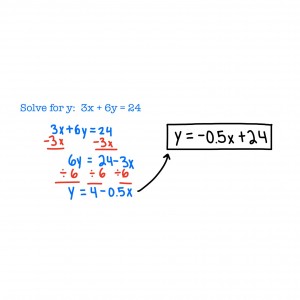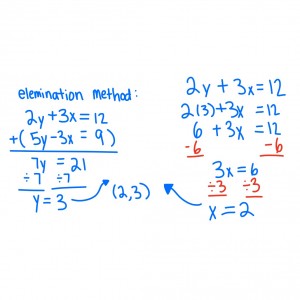Solving Equations
Solving an equation basically means to find the value of a variable. You don’t need any numbers to solve unless you need a specific answer like in word problems. To solve an equation you need to do whatever you can to get the variable (as a whole) on its own and anything left over on the other side of the equal sign. For example if your equation is 3x + 6y = 24 and your solving for y then you need to first get the y’s by themselves. Then you divide every thing by six (because whatever you do to one side, you do to the other) to get 6y to just y. y = -0.5x + 4.
Solving Systems of Equations
Solving a system of equations is to find where the two equations meet. There will always be two major steps no matter which method you use. The first step is to find one variable and the next is to plug that value into an equation to find the other value. One method is the equal values method. You use this method when both equations equal the same variable. To set it up, you need to remove whichever variable they both equal & make both equations equal each other. Then you solve for the remaining variable. This will give you the first variable. Lastly, you plug in that variable into one of the first equations and solve for the other variable. This will give you the second variable. The second method is the substitution method. You use this method when one equation had one variable by itself on one side of the equal sign and the rest on the other side. All you have to do is substitute the value of the variable and plug it into the other equation. Once you find the value of the first variable, you plug the value into the other equation to find the second variable. The final method is the elimination method. This method is probably the fastest and is used when both equations are written in standard form. You combine both equations to try to get rid of one of the variables. Once you get the leftover variable’s value, you plug it in to either equation and find the second variable.






Leave a Reply